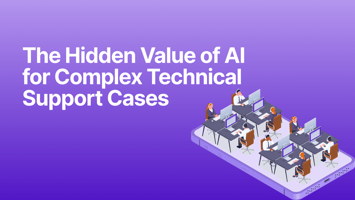The Silent Productivity Killer
The New Support Tech Stack: Human + AI, Not Human vs. AI

For years, people have framed customer support as a binary choice: either humans handle your customers, or AI does. It’s neat and simple but it's also wrong.
The reality is much messier. Chatbots promised to take care of “easy” tickets, but what’s left for human agents is usually the hardest, most complex, and emotionally charged cases. Customers expect personalized answers at speed and get pissed when you can't meet those expectations. Agents are under pressure, bouncing between tabs, apps. and other customers just to piece together the full story. And leaders are left in a bind: hiring more headcount is costly, but relying too much on automation risks alienating customers who still want empathy.
The truth is, support doesn’t need to be human or AI. Proper support is the right combination of both.
Support Today
Support teams are working harder than ever: your average agent toggles between apps and sites nearly 1,200 times per day - that adds up to almost five weeks every year just spent reorienting themselves after switching tools. When customers finally reach a person, they expect them to be fully prepared with the solution ready. According to Zendesk, 70% of customers expect agents to already know who they are and what they’ve been through - without having to repeat themselves. When that context is missing, frustration rises. It also impacts the bottom line. Zendesk found that 60% of consumers have chosen a brand because of the service they expected to get, not just the product. So there's a 50:50 chance you lose out on a customer because your service is subpar rather than your product.Why "Human vs. AI" Misses the Point
So where does AI fit? Too often, the conversation focuses on replacement: should humans or AI run support? That's the wrong question. AI is great at pulling knowledge from different systems, summarizing history, and suggesting next steps. Humans are great at judgment, empathy, and trust-building. One without the other falls short.
It’s not a one or the other - it’s a partnership. Think about flying: pilots don’t fly without autopilot, and autopilot can’t fly without pilots. Each extends the other’s capabilities. In support, humans and AI copilots should work the same way - covering each other’s blind spots to create better experiences.
Enter the Support Copilot
This is where the support copilot comes in. Instead of being yet another standalone tool or customer-facing chatbot, a copilot works inside the tools your agents already use. It helps in the background, keeping the human in the loop.
A copilot might surface the right Jira tickets the moment a bug is reported in Zendesk. It might draft a thoughtful first response in Gmail so the agent can fine-tune tone. It might guide an agent step-by-step through a tricky workflow in Slack, ensuring nothing gets missed.
In controlled experiments, AI assistance boosted agent productivity by 15% on average - with the biggest gains for less-experienced agents. Early adopters in support report even bigger outcomes: 61% productivity improvements and a 35% reduction in service costs when copilots are integrated effectively.
The Future of the Support Tech Stack
The old support stack was built around deflection and reporting - send customers to your FAQs to learn more or email support if the chatbot could only help so much. It forced agents to cobble together context manually, while customers rolled their eyes as they repeated the same story to multiple people.
The new support stack looks different. Leaders are starting to add a copilot layer - a connective tissue that unifies existing tools and delivers the right context directly into the agent’s workspace.
And the timing couldn’t be more relevant. According to Stanford’s 2025 AI Index Report, 78% of organizations reported using AI in 2024, up from 55% the year before. Adoption is soaring, but here’s the catch: McKinsey found that only ~1% of companies believe they’ve reached AI maturity, meaning they’ve truly integrated AI into workflows with measurable results.
From Fear to Optimism
The mindset is changing, too. A year ago, many leaders were worried about AI replacing their teams. Now, the tone is different: 61% of C-level support executives say they’re more optimistic about AI enhancing their team’s productivity than they were last year.
And for good reason. McKinsey’s research shows that when employees do get the right tools, AI can lift productivity across industries by 0.5 to 0.9 percentage points annually through 2030. The challenge is making sure AI actually helps. Employees themselves are saying they want better training and smoother integration with existing workflows before they can truly benefit.
That’s exactly why the copilot model makes sense: it doesn’t add another dashboard or tool for agents to learn. It shows up right where they already work.
The Next Question to Ask
If your support strategy feels stuck between adding more agents or leaning harder on automation, maybe it’s time to reframe the question:
How can humans and AI work together to deliver better support?
Ready to see this in action? Try the PixieBrix Customer Support Copilot - built for real support teams, not ticket deflection.
✅ DOM-aware context across Zendesk, Jira, Gmail, Slack
✅ One-click actions to reduce escalations
✅ Your choice of LLMs (bring your own OpenAI, Anthropic, or others)
✅ Free through 2025 for Seed–Series B SaaS


